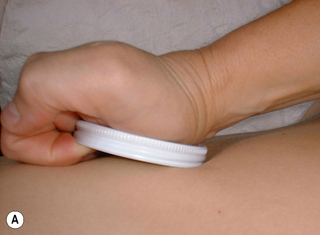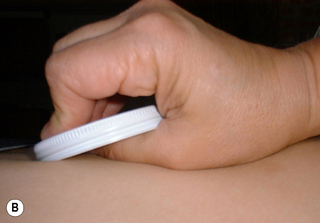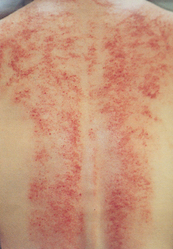Chapter 7.10 Gua sha Gua sha is an essential modality of traditional East Asian medicine (TEAM), defined as instrument-assisted unidirectional press-stroking of the body surface that intentionally creates transitory therapeutic petechiae representing extravasation of blood in the subcutis. Gua sha has been used for centuries in Asia, and Asian immigrant communities, as a form of self or familial care in the home (Hautman 1987; Craig 2002), and by acupuncturists and practitioners of TEAM worldwide in clinical practice (Nielsen 1995; Zhang & Hao 2000).1 With the advance of TEAM outside of Asia, Gua sha has been used over broad geographic areas, in multiple cultural settings, and by millions of people. Gua sha consists of repeated unidirectional press-stroking with a smooth-edged tool at a lubricated area of the body until sha petechiae appear (Fig. 7.10.1). Gua sha can be applied with a simple metal cap with a round lipped edge. Traditional tools include a soup spoon, coin, honed horn, bone, jade, or stone (Fig. 7.10.2). Fig. 7.10.2 • Gua sha tools: soup spoon, honed pieces of water buffalo horn and simple evenly round-lipped metal caps. The warming, cooling and/or neutral lubricants from Badger Balm (www.badgerbalm.com) are shown at the top. Nielsen A. Unidirectional ‘press-stroking’ accurately describes the operation of Gua sha, though a literal translation of ‘gua’ from Chinese is to ‘scrape’ or ‘scratch’ (So 1987). While scraping implies abrasion to the surface, the skin remains intact; there is no abrasion or bruising, merely petechiae and ecchymosis beneath intact skin. The term ‘sha’ has several meanings. Sha describes surface ‘blood stasis’ in a symptomatic or pre-symptomatic state. Sha also describes the petechiae raised from Gua sha. The literal translation of ‘sha’ from Chinese is ‘sand, sharkskin, or red, raised, millet-size rash.’ The fresh petechiae raised from Gua sha immediately begin to fade and blend to ecchymosis. See Figures 7.10.3 and 7.10.4. Fig. 7.10.4 • Picture taken the day after Gua sha treatment showing the fading of ecchymosis. Nielsen A. Sha is also translated as cholera, wherein sha blemishes resemble cholera’s end-stage rash. Gua sha in the East, like frictioning in early Western medicine (Jackson 1806), was used in the treatment of cholera and cholera-like disorders (So 1987), mimicking the crisis stage of the illness to produce a cure (Nielsen 1996). Common translations of Gua sha in Western medical literature include ‘coining,’ ‘scraping,’ ‘spooning,’ ‘cao gio’ (Vietnamese) and ‘kerik’ (Indonesian) (Nielsen 2009). Gua sha is indicated for pain, problems with movement or range of motion, and/or disturbed organ or system function, including acute infectious or chronic illness (Nielsen 1995; Zhang & Hao 2000). In TEAM, pain represents stasis, reflected in the Chinese aphorism: ‘No free-flow: pain; free flow: no pain’ (Nielsen 1995). Sha is a form of blood stasis in the surface tissue where pain is fixed, persistent or recurring. Pressing palpation confirms sha stasis when blanching appears that is slow to fade (So 1987), indicating normal surface perfusion is hindered. (See Plates 7.10.1a, b and c.) The patient may notice an achy sensation during palpation that may ramify to other areas of the body. Sha may also be accompanied by fatigue. In TEAM, this stasis in the surface tissue is thought to express from, and to, internal organ or system function (Epler 1980; Lu & Needham 1980). The benefits of Gua sha are commonly felt immediately and are sustained, to some degree, over time, where repeating treatment may be indicated to reach maximum benefit. The recovery of the tissue is expressed not only by immediate improvement in pain status, but by changes in pulse, tongue, digestion, urine, stool, sleep, libido, flexibility, mood as well as other presenting symptoms (Kaptchuk 2000). A 2005 search of the Chinese medical literature database from 1984 to 2004 identified 120 studies using Gua sha for painful musculoskeletal conditions, as well as acute infectious illness, respiratory conditions, and autoimmune and inflammatory disorders (Nielsen 2009). A 2011 literature search found over 600 articles and studies on Gua sha in the Chinese medicine database in areas of internal medicine, surgery, gynecology, pediatrics, pain management and general medicine (Nielsen 2012). There are randomized controlled trials in the Western literature for the effective use of Gua sha for neck pain (Braun et al. 2011) and breast engorgement (Chiu et al. 2010) as well as case reports of Gua sha in treatment of migraine headache (Schwickert et al. 2007), post herpetic neuralgia (Nielsen 2005). Chan et al. (2011) report a case where one Gua sha treatment reduced elevated liver enzymes and chronic inflammation in a patient with chronic active hepatitis B. Gua sha is contraindicated where the dermis or flesh is injured or compromised as in sunburn, abrasion, rash or contusion (Nielsen 1995). In cases of injury, Gua sha may be applied, but not at the area of trauma. • not contraindicated for patients who are weak or menstruating • not contraindicated for pregnant women if over limited areas and can be indicated where other medicine is unsafe as in sinusitis, colds and cough, for headache, neck, shoulder, back and hip pain, and for sciatica (author’s experience) • not contraindicated in patients with a stable INR (international normalized ratio) who take anticoagulation medication because the capillary bed is not damaged with Gua sha (Nielsen et al. 2007).2 What a provider observes when applying Gua sha is a gradual expression of small red petechiae (that can sometimes be brown, blue, very deep red or nearly black). The patient often feels exhilarated, invigorated, even excited. Acute pain is immediately affected, sometimes completely resolved. Nausea and vomiting cease (So 1987), wheezing and shortness of breath lessen or completely resolve; other acute symptoms are mitigated or resolve completely (Nielsen 1995). It would appear that it is the closely timed repeated press-stroking, the unidirectionality and the intentional extravasation of petechiae and their resolution over time that have physiological significance.
Introduction
Gua sha terms
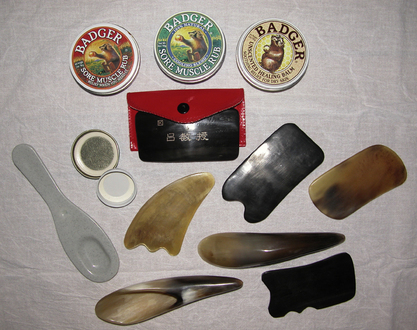
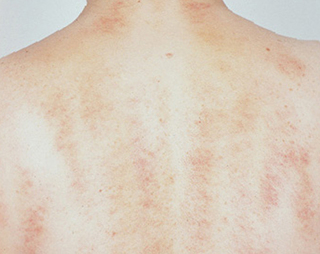
Indications
Contraindications
Biomechanism/physiology
![]()
Stay updated, free articles. Join our Telegram channel

Full access? Get Clinical Tree


Musculoskeletal Key
Fastest Musculoskeletal Insight Engine

